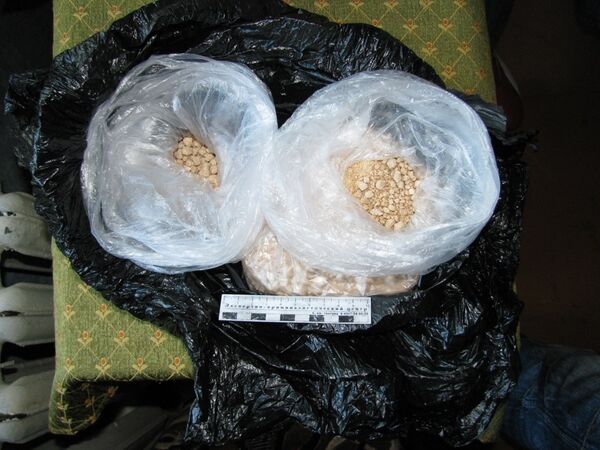Criminologists distinguish between personal and impersonal drug smuggling methods. In the first case, smugglers personally transport drugs across the border.
Capsules holding drugs are often swallowed and transported inside the stomach. Although this widespread smuggling method frequently kills the drug courier, the desire to make money is greater than the fear of personal injury or death.
In 2006, a record 320 capsules filled with over 330 grams of heroin was discovered in the stomach of an Australian woman.
Customs services have found that drugs are most often smuggled in suitcases and bags with false bottoms. Drugs are also transported inside various household items, vehicles or freight containers.
Drugs have been found inside car doors, engine compartments, dashboards, seats, specially equipped spare-tire wells, additional gas tanks, etc. Liquid drugs have also been found inside windshield-wiper fluid tanks.
Drugs are often concealed inside rest rooms and other public facilities on passenger trains and ships, making it difficult to expose the culprits.
In some cases, drugs are placed inside wooden furniture parts. Drugs are often hidden in clothes.
When drug couriers are not directly involved in transporting the drugs across the border, it is considered impersonal smuggling. In 1993, a 1,000-kg cocaine shipment was seized at the Torfyanovka customs checkpoint of the Vyborg customs house.
The drugs were hidden inside cans and imported into Russia as canned meat purchased by a Russian company from a Colombian agricultural enterprise.
Drugs can also be mailed inside letters, packages and parcels.
Drugs have been discovered in frozen fish (inside the fish or in between the fish in a crate), shrimps, exported coffee bags, book bindings, crafts (both inside them and in crafts made with the addition of cocaine), in the form of resin inside false-bottom tanks, canned liquids, bottles of alcohol, etc.
Chemicals used in drug production are transported in boxes of fruit, vegetables and other essential items.
In the United States, border security was tightened following the September 11, 2001 terrorist attacks in New York City and Washington, DC. Drug couriers have become more inventive in response. Smugglers use new methods, and they have also revived some long-forgotten methods, including using speedboats on the sea.
Drug smugglers in the Caribbean Sea and the Pacific Ocean fasten metal drug containers to the bottom of cruise ships, where they are retrieved by scuba divers when the ships drop anchor at U.S. ports.
Smugglers from Mexico and Colombia soak shirts and sweaters in liquid heroin, dry them and pack them inside suitcases, allowing them to evade airport customs officers and drug-sniffing dogs. Upon arrival in the United States, the heroin is washed off with water and turned back into powder.
Peruvian drug barons came up with one of the most unusual methods of smuggling their products across the border. They used giant Argentine termites to smuggle opium to a European heroin lab, which were ostensibly being sent to a biological institute in Germany. Each termite was covered with a thick layer of opium, which was so skillfully applied that the police had trouble finding the drug.
The crime rings in Palermo, Sicily, have their own unusual smuggling method. Police have repeatedly arrested drug runners transporting drugs in hearses.
Mexican customs officers have uncovered an unusual method of smuggling cocaine across their border. Colombian smugglers tried to bring in a jeep with 13 parts made from a combination of fiberglass and cocaine. The contraband was exposed with the help of police informants and drug-sniffing dogs.
The police are now trying to find a way to extract cocaine from fiberglass. It appears that drug barons have invented a new process unknown to science.




